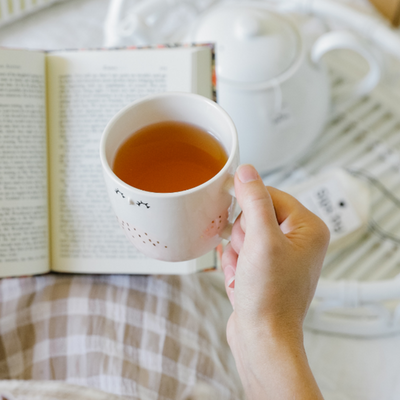
Tea bags are convenient, lightweight, packable, and easy to store or organize - but how do these magical little pouches produce so much delicious tea? If you’ve ever questioned how much tea is really in a tea bag, learn exactly what is in your tea bag plus how many you need to make a perfect cup of tea.
Sips by is a personalized tea discovery subscription. Each month, we match tea drinkers across the U.S. with delicious teas from over 150 global tea brands that we’re sure they’ll love. Members receive 4 teas chosen just for them in every box. Learn more about our tea subscription service.
SHOP BEST BAGGED TEA
Shop the best bagged teas as rated by Sips by's 700,000 tea-loving Members. Across all tea types, from black tea to green tea to herbal tea and more, these are the best tea bags from premium tea brands around the world. No matter the type or flavor of bagged teas you're searching for, Sips by has options you'll love to explore. Discover your new favorite tea bags today.

HOW MUCH TEA IS IN A TEA BAG?
Regular tea bags will contain 1.5 - 3 grams of loose tea leaves. This amount of tea is usually meant to be infused into 6 - 8 ounces of water, or one cup, for 3 - 5 minutes. For reference, 4.2 grams only equals one teaspoon, so how does such a small amount of tea leaves make a whole cup of brewed tea?
TEA BAGS
Most mass-produced, rectangular tea bags contain fannings, or tea dust, which are the smaller, crushed leaves from the “bottom of the barrel.” These require less tea than whole leaves because they will steep quickly and still produce a dark liquor.
However, not all tea bags with crushed leaves should be considered low quality, as several herbal teas, CTC (crush, tear, curl) black teas, fine rooibos teas, matcha, and various tea blends are simply processed with small, crushed tea leaves or ingredients to produce the desired flavor or infusion.
Try out these high-quality, convenient tea bags today.
SACHETS AND PYRAMIDS
Higher grades of tea bags will even contain large whole leaf teas in portioned sachets or pyramid bags. These types of tea bags, usually shaped like a large triangle, practically contain loose leaf tea and may have up to 6 grams of tea per bag, which is double or triple the amount of regular tea bags. When you make loose leaf tea using tea infusers, the typical measurements are 1 - 2 teaspoons per 8 oz cup because larger leaves, herbal, and dried ingredients need more quantity to produce a fuller flavored tea when compared to the classic rectangular bags.
These bags are also much larger to allow the leaves to unfurl inside the tea bag. So don’t worry if it doesn’t look like there is a lot of tea in the sachet or pyramid bags when it’s dry, because once steeped, the leaves will fully expand to fill up your whole tea sachet or pyramid. Another benefit of tea sachets and pyramids is that they can often be re-steeped at least 1 - 2 times because they contain whole tea leaves, whereas tea bags with crushed leaf tea does not usually have enough potency to be infused twice.
Discover new premium sachet and pyramid tea bags with your own Sips by Box.
HISTORY OF TEA BAGS
The history of the typical tea bag has two competing origin stories. The first story is that two women, Roberta C. Lawson and Mary Molaren, applied for a patent in 1901 for a mesh “Tea-Leaf Holder” because they recognized that some people wanted to only brew a single teacup without wasting a whole pot, yet the leaves couldn’t be allowed to float freely.
The second story is attributed to Thomas Sullivan in 1908, a New York tea and coffee merchant who sent out tastings of his tea in small sample bags and customers assumed they were meant to place the whole bags in their pots. Because the sample pouches were silky and porous, the tea leaves still infused their water and customers found them convenient as there was no need for a messy teapot or strainer. With feedback from his accidental product testers, he started making tea bags from gauze and then paper.
While it’s unclear how the first tea bags became popular, by the early 1920s they were being successfully marketed throughout America. Several improvements were even made by this point, such as providing two different sizes of tea bags, a family size one with enough tea for a standard teapot and a small bag meant for only a single cup, plus attaching both with strings and tags for easy removal after steeping.
WHAT KIND OF TEA IS IN A TEA BAG?
One of the best features of tea bags is their versatility. Tea bags can contain any and all types of tea leaves! The most popular tea bags range from strong black tea blends such as English Breakfast or Earl Grey to light herbal flavor infusions like peppermint or chamomile. However, the best bagged teas are any type of tea that taste good to you! Because tea bags make whipping up a single cup of brewed tea quick and easy, experiment with different, exciting blends such as a Raspberry Oolong by Shantea Thyme. Or, you can even make your own tea bags out of your favorite loose leaf teas, and even mix and match them, with these biodegradable paper filters.
Try more bagged teas with your own Sips by Box.
HOW TO STEEP TEA BAGS
The reason why tea bags sprung into popularity and were quickly adopted is that one seems to work for every tea drinking situation. No matter which cup you’re using, you can just plop in one tea bag and sip away without giving it a second thought. Even though tea bags are easy to use and significantly minimize clean-up, there are a few guidelines to keep in mind when steeping tea bags to make sure you’re getting the best cup of tea possible!
Remember to adjust the amount of tea bags you use when making a teapot or pitcher of tea. You might need to use 2-4 tea bags - depending on how many ounces of water your teapot or pitcher holds - to brew a delicious, strong pot of tea.
Also, if you’re making iced tea it’s a good rule of thumb to double the amount of tea you use so the flavor won’t be watered down by ice. If your iced tea ends up too strong, you can always add more cold water to dilute the brew!
Other important factors for steeping the perfect cup of tea is making sure steep your tea bags at the correct water temperature for the right amount of time. This guide breaks down the recommended water temperature for steeping each type of tea bag.
- Herbal: 212℉ // Hard boil
- Rooibos: 212℉ // Hard boil
- Pu-erh: 212℉ // Hard boil
- Black: 205℉-212℉ // Soft boil
- Oolong: 185℉-195℉ // Light steam
- White: 175℉-185℉ // Light steam
- Green: 175℉ // Faint steam
Steeping times will vary depending on the type of tea you’re using, for example, how long it takes to steep black tea is very different from green tea or white tea. Our quick chart below will help you determine how long to steep your tea bags.
- Herbal: 5-10 minutes
- Rooibos: 6-7 minutes
- Pu-erh: 2-5 minutes
- Black: 3-5 minutes
- Oolong: 2-4 minutes
- White: 1-3 minutes
- Green: 2-3 minutes
Try more bagged teas with your own Sips by Box.
Interested in trying these teas and others? Subscribers receive 4 teas chosen just for them in every box. Learn more about our tea subscription box or explore the loose leaf tea shop.
About Sips by: We’re a female-founded and led startup that makes discovering tea fun, personalized, and affordable. The Sips by Box is the only multi-brand, personalized tea subscription box. Each month, we match tea drinkers across the U.S. with delicious teas from over 150 global tea brands that we’re sure they’ll love. Based out of Austin, Texas, we are adept at savoring a hot mug even when it’s seasonally inappropriate.


